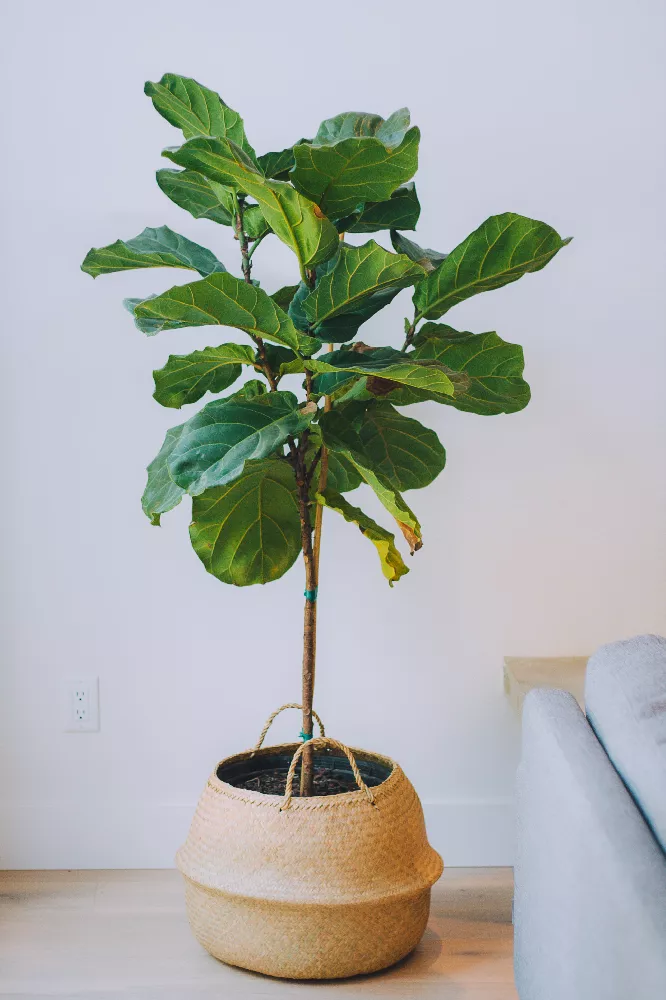- Home >
- Houseplants >
- Fiddle-Leaf Fig Trees
Fiddle-Leaf Fig Trees for Sale
- Ships in 1-2 days
- 1-Year Warranty Eligible
- Pots or accessories are not included unless specified in the product options.
Shipping Details:
Once your order is shipped, you’ll receive an email with a tracking number and estimated delivery date. Most orders ship immediately, but some items are seasonal and may only ship in spring or fall. These products are noted on the website.
Fiddle-leaf fig is a popular, showy plant to grow as a houseplant. If you live in an area that is warm and humid, such as Florida or Louisiana, you might be able to grow your fiddle-leaf fig tree (Ficus lyrata) outside. However, the focus of this article is on growing them indoors as a houseplant. There are three reasons you might want to grow a fiddle-leaf fig tree in your home:
- They are a showy plant that make for an excellent focus in any room.
- They can grow as tall as 10 feet with proper care.
- They are popular and show your prowess as an indoor gardener.
Plant Care
Sunlight
Fiddle leaf figs thrive in bright sunlight, so place them in a window that gets at least 5-6 hours of sun a day.
Watering
Water when the top inch of soil is dry. Water deeply but make sure the container drains well afterwards.
Fertilizing
Fertilize with a slow-release, balanced fertilizer formulated for house plants throughout the growing season.
Planting and Care
Planting instructions
Begin with a healthy plant, especially if it is your first one. Before bringing home a fiddle-leaf fig tree from the nursery, check for the following conditions:
- Brown or yellow leaves. A fiddle leaf fig’s leaves will not heal or return to being green once they are damaged.
- Check for tiny insects, webbing, or mildew. Not only is this a plant that will need extra care initially, the condition might spread to your other plants.
When you purchase your fiddle leaf fig, buy a pot that is about two inches bigger than the one in which it is already growing. Prepare a catchment tray filled with pebbles to go under the pot. A natural pot with a good drainage hole is ideal. An absorbent mat under the stones will help maintain humidity for your fig tree.
Place some rough aggregate at the bottom of the pot, such as gravel or broken pottery pieces. This will help protect the drain holes. Gently tip the fig tree out of its current pot. Add enough soil in the new pot to reach about a half inch below the rim of the new pot. The potting mix should be one that facilitates good drainage.
Watering and nutrients
Fiddle-leaf fig trees are picky about water. They are an African rainforest plant, which means that they like to have fresh water frequently, but they are also prone to root rot if they are in standing water. They prefer a higher humidity than is normal in most homes, so you might want to position a humidifier near your fig tree.
Fertilize your tree during the summer months when it will do most of its growing. You can purchase a fertilizer designed especially for fiddle-leaf figs, or look for a plant fertilizer that has an N-P-K ratio of 3:1:2. Feed approximately once per month throughout the spring and summer according to package directions. Do not feed in fall and winter.
Lighting
Fig trees get a lot of their nutrients from sunlight on their beautiful, oversized leaves. This means they need to receive a lot of sunlight, but not too much sunlight. One way to achieve this is to set your tree in front of an east or west facing window that has a sheer, gauze curtain over it. Open the regular drapes during the day, then close them at night to keep from chilling your plant. Turn your fiddle-leaf fig daily to keep it growing straight, and not slanting toward the light.
Pruning
Over watering and excessive sunlight are two leading causes of brown spots on fiddle-leaf fig tree leaves. Yellowing with a brown center often indicates over-watering. As opposed to puckery brown patches irregularly placed which typically indicate sunburn or an insect invasion.
Trim away damaged leaves. The leaves will not heal, but once they are gone, new leaves can grow. If your fig tree has gotten too tall and too leggy, simply cut off the top and use the cut part to start a new plant.
Propagation
Despite pictures where fiddle leaf fig starts are shown with roots growing from leaves, they will not create new plants this way. To start a new fig tree, make a 45 degree cut just below a limb bud using a clean pair of shears. Ensure there are at least three leaf nodes on your cut twig. Without the twig and nodes, the plant will not have any way to develop into a full plant. It will usually take four to six weeks to get a new fiddle leaf fig to take root.
You can start the new plant by placing the cut twig in water, by placing it in soil, or by air layering.
To start your plant in water, be sure to strip away the lower leaves and change the water at least every other day. As soon as the roots begin to develop, transfer your new plant to a fluffy sterile growing mixture (if the mixture is too heavy it will put undue pressure on the fragile roots).
A better method is to dip the cut end of the twig in a growing medium. Snip away the lower leaves. Use a pencil or stake to open a hole in the medium, then insert the cut stem. Water daily, but make sure that the growing medium drains well so that the cutting is not in standing water.
A third method is air layering. Strip away a band of bark, then paint the cut with a growth starter. Follow up by binding a sterile growing medium around the cut part, then cover with plastic wrap. Water the bundle daily until roots appear, then cut the new plant away from the parent tree.
Pests, diseases, and animals
Just about every pest known to growers loves fiddle-leaf fig trees. Prevention is best, with special attention to watering, sunlight, and humidity. When that fails, look for fiddle-leaf fig sprays or fertilizer.
Pets can also be a problem. Your fiddle-leaf tree should be protected from dogs or cats because it is poisonous to animals.
FAQs
Why are the leaves on my fiddle-leaf fig tree developing tiny brown spots?
There is a good chance that your plant is infested by spider mites. Use neem oil or a miticide developed for fig trees.
What is the best kind of pot for a fiddle-leaf fig tree?
Because they need good drainage, a natural material pot, such as terracotta or clay is best.
Can I use a self-watering pot for a fiddle-leaf fig tree?
Yes. First, get the plant acclimated to the pot, then try watering using the reservoir. Watch the water meter. If the plant uses all its water in a day or two, then its roots have reached the reservoir. Do not top water after the plant is using the reservoir.
Compare Similar Products
Customer Reviews
Healthy, beautiful plant!
My overall experience was good and I love the plant, but it had a few bugs on it when it arrived. I recommend opening the plant outside first or the company could make sure no bugs are in the Fig Tree.
Purchased and had it sent to a family member, they loved it and sent pictures, it looks great for being shipped! Satisfied customer, will be purchasing more for myself.
Looks great! Impressive and attractive plant. Large shiny interesting leaves. Arrived with support stick attached...not sure if it should be removed
Great tree! We









